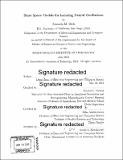State space models for isolating neural oscillations
Author(s)
Beck, Amanda M
DownloadFull printable version (4.720Mb)
Other Contributors
Massachusetts Institute of Technology. Department of Electrical Engineering and Computer Science.
Advisor
Patrick L. Purdon.
Terms of use
Metadata
Show full item recordAbstract
Information communication in the brain depends on the spiking patterns of neurons. The interaction of these cells at the population level can be observed as oscillations of varying frequency and power, in local field potential recordings as well as non-invasive scalp electroencephalograms (EEG). These oscillations are thought to be responsible for coordinating activity across larger brain regions and conveying information across the brain, directing processes such as attention, consciousness, sensory and information processing. A common approach for analyzing these electrical potentials is to apply a band pass filter in the frequency band of interest. Canonical frequency bands have been defined and applied in many previous studies, but their specific definitions vary within the field, and are to some degree arbitrary. We propose an alternative approach that uses state space models to represent basic physiological and dynamic principles, whose detailed structure and parameterization are informed by observed data. We find that this method can more accurately represent oscillatory power, effectively separating it from background broadband noise power. This approach provides a way of separating oscillations in the time domain and while also quantifying their structure efficiently with a small number of parameters.
Description
Thesis: S.M. in Computer Science and Engineering, Massachusetts Institute of Technology, Department of Electrical Engineering and Computer Science, 2018. Cataloged from PDF version of thesis. Includes bibliographical references (pages 55-56).
Date issued
2018Department
Massachusetts Institute of Technology. Department of Electrical Engineering and Computer SciencePublisher
Massachusetts Institute of Technology
Keywords
Electrical Engineering and Computer Science.